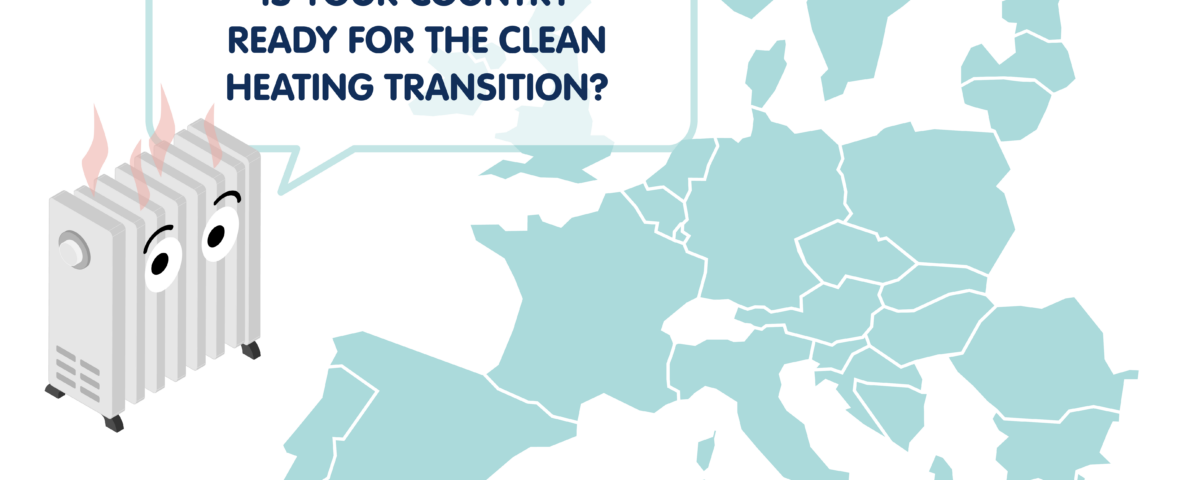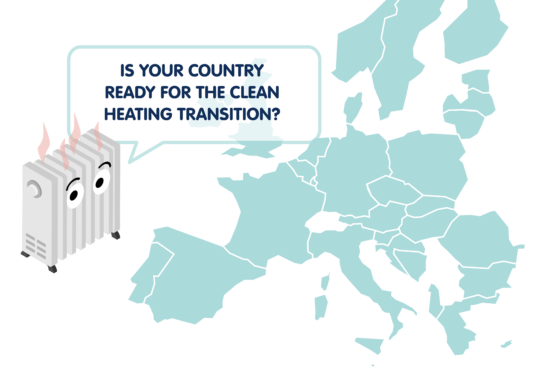Most households in low-income countries cannot afford to buy clean heating solutions despite green subsidy schemes becoming increasingly popular, a new analysis shows. This leaves people with no choice but to install overly subsidised gas boilers, which are threatening Europe’s decarbonisation goals.
A household in Bulgaria, Hungary, Poland, Portugal or Romania may take 10 years longer than one in France, Germany, Italy or the UK to recover the installation costs of a heat pump, and five or more years longer for solar thermal installations. These are the findings of the latest analysis by the European Environmental Bureau (EEB) on behalf of the Coolproducts campaign.
See interactive map and methodology below
The study identifies the initial investment required to buy clean heating solutions as one of the main reasons behind the slow uptake of this technology in parts of Europe and blames a combination of insufficient and inconsistent incentives.
On the one hand, loans, grants, and tax reductions are not sufficient to support the shift widely and fairly across the population, with most people in low-income countries unable to afford this technology.
On the other hand, in most cases, governments have been found to still use ‘green’ energy schemes to finance the installation of new gas boilers, which typically cost three times less than a heat pump despite posing one of the greatest challenges to achieving climate neutrality.
The analysis does not consider other reasons contributing to the slow uptake of clean heating, namely the huge amounts of fossil fuel subsidies reducing the cost of gas heating, and the slow insulation rates in some countries – both of which hinder the energy saving potential of renewables.
The heating and cooling sector is responsible for a third of the EU’s CO2 emissions, with gas boilers being the main source. The European Commission estimates that a 40% reduction in gas heating emissions is needed to achieve the EU’s 2030 climate targets, while a study by Coolproducts partners ECOS finds that a total phase-out of gas and oil boilers is needed by 2025 if Europe wants to achieve carbon neutrality by 2050.
Coolproducts campaigners call on EU governments to:
- Make use of the money in the EU’s Recovery Fund to boost support for clean heating technologies widely across the population. These include solar thermal systems and heat pumps with low Global Warming Potential (GWP) refrigerants
- Phase out subsidies for new gas boilers
- Phase out the sales of new gas boilers by 2025
- Ensure National Climate and Energy Plans include adequate subsidies to help all citizens make the switch
Facts and figures
- A household in Eastern Europe may take eight to 15 years to offset the installation costs of a heat pump. In Western Europe, consumers may take less than two years to recover the costs for solar thermal installations, and less than four for a heat pump – see methodology below.
- 24 countries allocate direct grants to support the installation of heat pumps; five prefer tax reduction schemes; nine give out loans. 10 countries had more than one scheme in place.
- 23 countries allocate direct grants tu support the installation of solar thermal systems; seven prefer tax reduction schemes; nine give out loans. 10 countries had more than one scheme in place.
- Italy is the only country where the government subsidises the entire cost of a heat pump, provided that households meet certain conditions. However, the government also subsidises oil, gas, and LPG boilers.
- Europe’s heat pump market increased by 19% in 2019, compared to the previous year. Nordic countries have the largest stocks per capita, while France and Italy lead in terms of sales growth overtime.
- The UK has made the uptake of heat pumps in British homes a central part of its efforts to achieve climate neutrality, planning a 20-fold increase from the current rate of 1%.
Methodology
The study estimates the time that households in the EU-27, Norway, and the UK would take on average to either repay a bank loan or recover the funds invested to buy a heat pump or a solar thermal system using their own finances. The analysis considers the national subsidies that each household is entitled to; the average annual net income of a one earner couple with two children (Eurostat 2020); an estimation of the average installation costs for heat pumps (€10,000) and solar thermal systems (€5,000).
Governments may give out subsidies in the form of grants, tax rebates and loans. For the purpose of the study, we take into account only the most favourable subsidies for households, which in most cases are grants (check out the country boxes in the map for more details).
The estimated number of years needed to recover the initial investment assumes that each household would allocate a sustainable monthly instalment – one that would not lead to a noticeable lifestyle change, which we assume to be around 5% of their monthly income – to recover the initial costs.
Note that the study only focuses on the initial investment and does not take into consideration the financial benefits resulting from energy savings. Energy savings associated with clean heating technologies may vary depending on home insulation and energy prices.
The information available in the map comes from several sources. All links are available in the accompanying report: Analysis of fossil fuel subsides in the heating and cooling sector across Europe.
Map legend
Subsidies to solar thermal systems – Index includes payback time for the investment: the longer, the worse. More than 6 years (Dark red); More than 4 years (Red); More than 2 years(orange); Less than 2 years (green); No available/comparable (grey)
Subsidies to heat pumps -Index includes payback time for the investment: the longer, the worse. More than 8 years (Dark red); More than 6 years (Red); More than 4 years(orange); Less than 4 (green); No available/comparable data (grey)
Subsidies to fossil fuel heating – Index compares how quicker is the payback of fossil heating vs renewable heating, all subsidies included: the higher, the worse. Less than 3 (Green), less than 4 (Orange ) less than 5 (Red) and more than 5 (Dark Red)



